So, for this post, I am revisiting a new found friend; the oldest resident member of the University of Virginia’s College at Wise library, the book: “Characteristics of Men, Manners, Opinions, Times”. This title is by the Right Honorable Anthony, Earl of Shaftesbury. The copy we have access to is a 1758 reprint of the work first published in 1711.
The book is bound; according to Angie Harvey, a lover of books and a core member of the library staff, it was probably rebound sometime during the 1960’s. When looking at the rebound cover of the book, it leaves something to be desired. It isn’t what one would expect from a book of this time period. It was rebound by the college, still when the institution was known as CVC: Clinch Valley College. I’m sure that their intentions when rebinding the book were less about preserving historical accuracy, but, more along the lines of being cost effective and maintaining the book
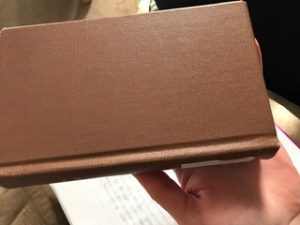
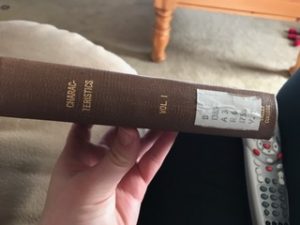
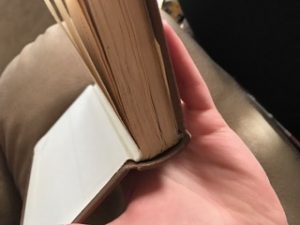
Upon opening the book and taking a closer look, it can be seen where holes had been stabbed through the pages, and we can also see the thread sewn through the holes.


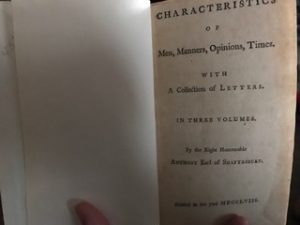
Thumbing through the book, I was surprised about the condition of the pages (Not everyone can look that good at 259 years old). Further observation of the paper resulted in me seeing these sort of “ridges”. So, I decide to make use of my flashlight and backlight a few pages. What do I see?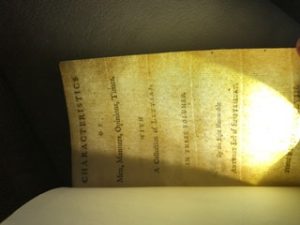 Chain lines! This means that these pages are crafted out of laid paper. The lines run horizontally, and to me, they are beautiful. I am free to make my way through all of the pages of the book; no folds had remained unopened. To my dismay, I did not observe any illustrations whatsoever in this work, and I unfortunately did not witness any water marks either. I am able to note however, that the pages of the book had been trimmed, and at one time would stack nice and neatly on top of one another.
Chain lines! This means that these pages are crafted out of laid paper. The lines run horizontally, and to me, they are beautiful. I am free to make my way through all of the pages of the book; no folds had remained unopened. To my dismay, I did not observe any illustrations whatsoever in this work, and I unfortunately did not witness any water marks either. I am able to note however, that the pages of the book had been trimmed, and at one time would stack nice and neatly on top of one another.

The book also did not bear a signature; no special combination of letters and numbers at the bottom of certain pages. Then also I determined what I believe to be the format of the book based on class assigned reading. I began by measuring the length of the pages, and they were found to be approximately 16 cm and the notes to add a centimeter or two to this measured value in order to account for any trimming. Another piece of information I used was the directionality of the chain lines, and in my case with this book they ran horizontally. From this data, I determined the format of this book to be duodecimo. With this information I am now going to attempt to calculate the how many sheets of paper were needed to produce this book:
There are 366 pages in this work:
366 / 2 = 183 leaves
183 leaves / 12 leaves per page (duodecimo) =15.25 sheets of paper!
Personally, I love how this book looks…But, I also love how it smells. This isn’t creepy, right?







 Chain lines! This means that these pages are crafted out of laid paper. The lines run horizontally, and to me, they are beautiful. I am free to make my way through all of the pages of the book; no folds had remained unopened. To my dismay, I did not observe any illustrations whatsoever in this work, and I unfortunately did not witness any water marks either. I am able to note however, that the pages of the book had been trimmed, and at one time would stack nice and neatly on top of one another.
Chain lines! This means that these pages are crafted out of laid paper. The lines run horizontally, and to me, they are beautiful. I am free to make my way through all of the pages of the book; no folds had remained unopened. To my dismay, I did not observe any illustrations whatsoever in this work, and I unfortunately did not witness any water marks either. I am able to note however, that the pages of the book had been trimmed, and at one time would stack nice and neatly on top of one another.
 We were also interested in taking a look at books that were well worn and had obvious use. They pointed us in the direction of the collection Gladys Stallard. Gladys was a local woman from Dorchester, which is a specific section of Norton, Virginia, and she had left her book collection to the college upon her death. The particular book I looked at from her collection was “Call Me Hillbilly” by Gladys Trentham Russell; she had written on the inside cover of the book that she acquired it in September 1974. This book talks about the lives of people that grew up in the Great Smoky Mountains near Gatlinburg, Tennessee. Within the book, it features pictures of people from the region and provides their names; alongside this information, Gladys Stallard had written in many birth dates and death dates of the individuals. Mrs. Stallard had also obtained book reviews of the text, and stapled them to the inside of the front cover.
We were also interested in taking a look at books that were well worn and had obvious use. They pointed us in the direction of the collection Gladys Stallard. Gladys was a local woman from Dorchester, which is a specific section of Norton, Virginia, and she had left her book collection to the college upon her death. The particular book I looked at from her collection was “Call Me Hillbilly” by Gladys Trentham Russell; she had written on the inside cover of the book that she acquired it in September 1974. This book talks about the lives of people that grew up in the Great Smoky Mountains near Gatlinburg, Tennessee. Within the book, it features pictures of people from the region and provides their names; alongside this information, Gladys Stallard had written in many birth dates and death dates of the individuals. Mrs. Stallard had also obtained book reviews of the text, and stapled them to the inside of the front cover. 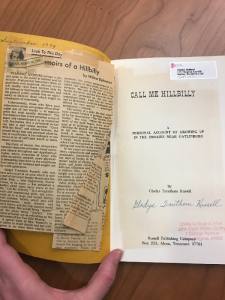 This was interesting, as it made me wonder if perhaps she had personally known the author or had some connection to her. It was easy to tell from the condition and the comments in the book, that this was one that she frequented often.
This was interesting, as it made me wonder if perhaps she had personally known the author or had some connection to her. It was easy to tell from the condition and the comments in the book, that this was one that she frequented often. 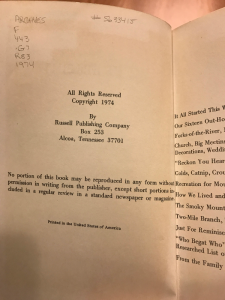 Looking at the other books in her collection, it would be safe to assume that Gladys was proud of and interested in preserving the lives and history of the people that live in the South-West Virginia and East Tennessee region.
Looking at the other books in her collection, it would be safe to assume that Gladys was proud of and interested in preserving the lives and history of the people that live in the South-West Virginia and East Tennessee region.